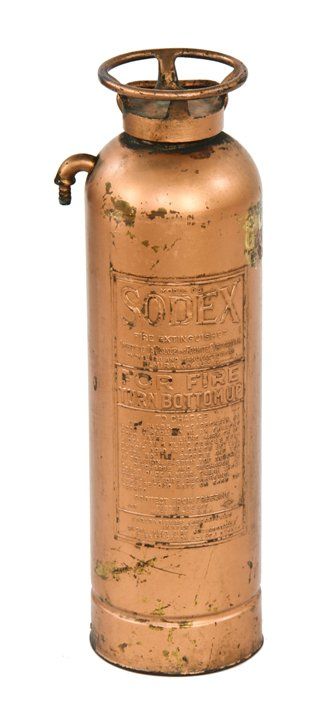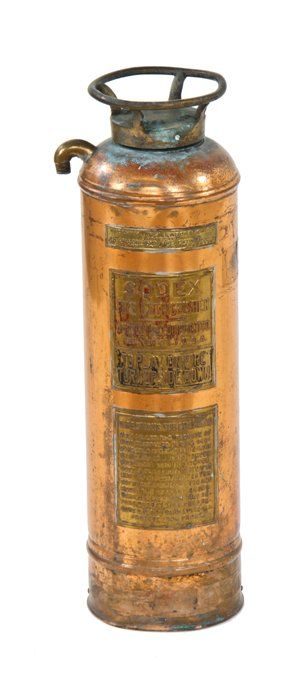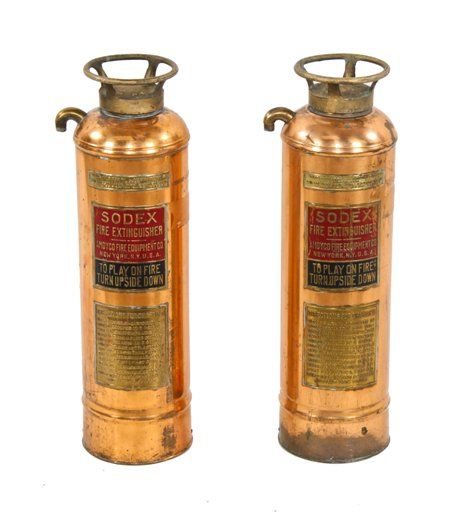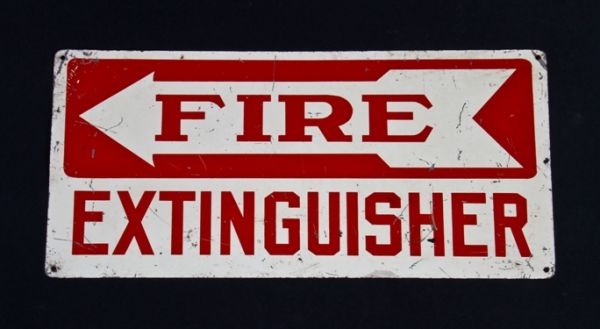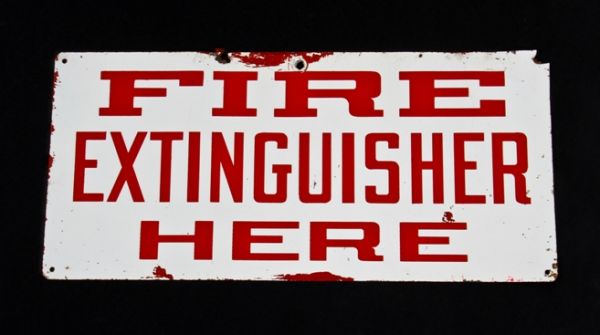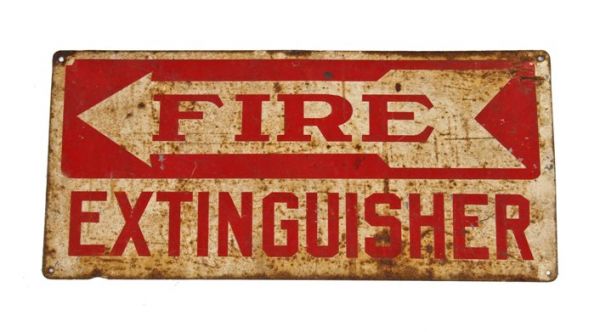original c. 1920's american vintage industrial metallic gold enameled copper metal "sodex" wall-mount fire extinguisher
SOLD
Out of stock
SKU
UR-15070-12
amdyco fire equipment co., new york city, new york
c. 1920's vintage american industrial wall-mount copper "sodex" fire extinguisher fabricated by the amdyco fire equipment co., new york city, new york. the canister or tank retains the original soldered embossed letter brass plaques. the solid cast bronze valve wheel, hose nozzle and wall hook are intact. the contents were removed long ago. the loose stopple type tank originally contained bicarbonate of soda and sulphuric acid. weathered and worn old metallic gold paint finish largely intact. the first fire extinguisher of which there is any record was patented in england in 1723 by ambrose godfrey, a celebrated chemist at that time and to this day. it consisted of a cask of fire-extinguishing liquid containing a pewter chamber of gunpowder. this was connected with a system of fuses which were ignited, exploding the gunpowder and scattering the solution. this device was probably used to a limited extent, as bradley's weekly messenger for november 7th, 1729, refers to its efficiency in stopping a fire in london. the modern fire extinguisher was invented by british captain george william manby in 1818; it consisted of a copper vessel of pearl ash (potassium carbonate) solution contained within compressed air. the soda-acid extinguisher was first patented in 1866 by francois carlier of france, which mixed a solution of water and sodium bicarbonate with tartaric acid, producing the propellant co2 gas. a soda-acid extinguisher was patented in the u.s. in 1881 by almon m. granger. his extinguisher used the reaction between sodium bicarbonate solution and sulfuric acid to expel pressurized water onto a fire. the cartridge-operated extinguisher was invented by read & campbell of england in 1881, which used water or water-based solutions. they later invented a carbon tetrachloride model called the "petrolex" which was marketed toward automotive use. the chemical foam extinguisher was invented in 1904 by aleksandr loran in russia, based on his previous invention of fire fighting foam. loran first used it to extinguish a pan of burning naphtha. it worked and looked similar to the soda-acid type, but the inner parts were slightly different. the main tank contained a solution of sodium bicarbonate in water, whilst the inner container (somewhat larger than the equivalent in a soda-acid unit) contained a solution of aluminium sulphate. when the solutions were mixed, usually by inverting the unit, the two liquids reacted to create a frothy foam, and carbon dioxide gas. the gas expelled the foam in the form of a jet. although liquorice-root extracts and similar compounds were used as additives (stabilizing the foam by reinforcing the bubble-walls), there was no "foam compound" in these units. the foam was a combination of the products of the chemical reactions: sodium and aluminium salt-gels inflated by the carbon-dioxide. because of this, the foam was discharged directly from the unit, with no need for an aspirating branchpipe (as in newer foam-compound types). in 1910, the pyrene manufacturing company of delaware filed a patent for a using carbon tetrachloride to extinguish fires. the liquid vaporized and extinguished the flames by inhibiting the chemical chain reaction of the combustion process (it was an early 20th century presupposition that the fire suppression ability of carbon tetrachloride relied on oxygen removal.) in 1911, they patented a small, portable extinguisher that used the chemical. this consisted of a brass or chrome container with an integrated handpump, which was used to expel a jet of liquid towards the fire. another type of carbon-tetrachloride extinguisher was the fire grenade. this consisted of a glass sphere filled with carbon tetrachloride, that was intended to be hurled at the base of a fire. carbon tetrachloride was suitable for liquid and electrical fires and the extinguishers were fitted to motor vehicles. carbon-tetrachloride extinguishers were withdrawn in the 1950s because of the chemical's toxicity–exposure to high concentrations damages the nervous system and internal organs.
You Might Also Like
WORDLWIDE SHIPPING
If required, please contact an Urban Remains sales associate.
NEW PRODUCTS DAILY
Check back daily as we are constantly adding new products.
PREMIUM SUPPORT
We're here to help answer any question. Contact us anytime!
SALES & PROMOTIONS
Join our newsletter to get the latest information

